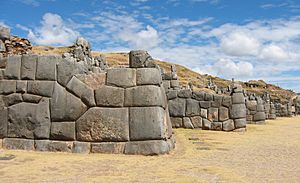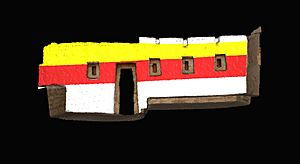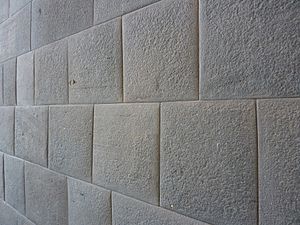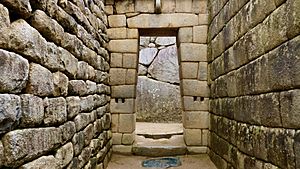Inca architecture facts for kids
Inca architecture is one of the most amazing building styles from ancient South America. The Incas learned a lot from older cultures like Tiwanaku, which started around 200 B.C.E. in what is now Bolivia. A key part of Inca building was using the natural land and materials around them in their designs.
The Inca capital, Cuzco, still has many great examples of Inca buildings. Even today, you can see Inca walls built into newer Spanish buildings. The famous royal estate of Machu Picchu (Machu Pikchu) is a perfect example of Inca architecture that still stands. Other important places include Sacsayhuamán and Ollantaytambo. The Incas also built a huge road network across most of western South America. They placed their unique buildings along these roads to show their power and control.
Contents
What Makes Inca Buildings Special?
Inca buildings were often made from fieldstones (stones found in fields) or carefully shaped stone blocks. They used dirt as a kind of glue, or "mortar", to hold them together. Walls made of adobe (sun-dried mud bricks) were also common, usually built on stone foundations. The materials they used depended on where they were. For example, on the coast, they used large adobe blocks. In the Andes mountains, they used local stones.
The most common shape for an Inca building was a rectangle. These buildings usually had no walls inside and were covered with wooden beams and thatch (straw roofs). There were different versions of this basic design. Some had gabled roofs (like a triangle), and some had one or two long sides open. Rectangular buildings were used for many things, from simple homes to grand palaces and temples.
Sometimes, Inca buildings had curved walls, especially outside the main area of Peru. Two-story buildings were rare. If they were built, you usually reached the second floor from outside using stairs or by walking up a hill. Openings like doors, niches (small alcoves in walls), and windows often had a trapezoidal shape. This means they were wider at the bottom and narrower at the top. Sometimes, they had double or triple jambs (side posts of a doorway) for decoration. Other decorations were rare. Some walls were painted or had metal plaques. Very rarely, walls were carved with small animals or geometric shapes.
A common group of Inca buildings was called a kancha. This was a rectangular area with three or more rectangular buildings placed around a central courtyard. Kancha units were used for many different things, from simple homes to temples and palaces. Many kancha could be put together to form blocks in Inca towns. The central part of the Inca capital, Cusco, was made up of large kancha, including Qurikancha and the Inca palaces. The best examples of kancha can be seen at Ollantaytambo, an Inca town along the Urubamba River.
Inca architecture is famous for its amazing stonework. Stones were cut and shaped so precisely that they fit together perfectly without any mortar (glue). However, most Inca buildings were actually made from fieldstone and adobe, as mentioned before.
Experts have studied Inca stonework. One type is called coursed masonry**, where stones are rectangular and laid in rows. Another is **polygonal masonry, where stones have irregular shapes but still fit together tightly. These types were used for important buildings or strong outer walls.

Some historians believe Inca stonework was inspired by the Tiwanaku culture in Bolivia, which existed centuries before the Incas. They think the Incas were impressed by Tiwanaku buildings and hired many stoneworkers from that area. Another influence came from the Wari culture. The Wari may have introduced the idea of building rectangular enclosures in the Cusco region, which led to the Inca kancha.
How the Incas Built Their Structures


Building large projects needed a lot of people! The Inca Empire had a system called Mit'a. This was a type of work tax where all men between 15 and 50 had to work on big public building projects. One Spanish writer, Pedro Cieza De Leon, wrote that the Inca ruler Pachacuti "ordered 20,000 men sent in from the provinces" to build Sacsayhuaman.
An engineer named Ken Wright thinks that 60 percent of Inca construction was actually underground. The Incas built their cities using materials found nearby, usually limestone or granite. To cut these hard rocks, the Incas used tools made of stone, bronze, or copper. They often split the stones along their natural cracks.
Teams of men moved the heavy stones by pulling them with ropes. Drawings by the chronicler Felipe Guaman Poma de Ayala show this. Cieza De Leon also wrote that "4000 of them quarried and cut the stones; 6000 hauled them with great cables of leather and hemp." The Incas made strong ropes from a type of grass called ichu. Small ropes could hold up to 4,000 pounds, and larger ones might hold up to 50,000 pounds! Since they didn't have wheels, the stones were rolled up with wooden beams on earth ramps. You can still see an unfinished ramp at a site called Sillustani.
It's thought that the stones were carefully moved into place using friction to create perfectly curved and hollowed-out sides. Marks left on the stones, like stone bosses (small bumps), were made using ropes. These marks showed the hard work involved and the power of the Inca rulers.
Inca building walls were usually slightly tilted inward, and their corners were rounded. This, along with their precise stonework, made Inca buildings incredibly strong against earthquakes. During a small or medium earthquake, the walls stayed stable. During a strong earthquake, the stone blocks would "dance" a little, moving slightly, but then settle back into their exact positions after the shaking stopped.
Another building style was called "pillow-faced" architecture. The Incas would sand large, smoothly shaped stones and fit them together like a jigsaw puzzle. This style was often used for temples and royal places like Machu Picchu.
The most sacred and important Inca buildings used a very refined type of stonework called ashlar masonry. Examples include the Acllawasi ("House of the Chosen Woman"), the Coricancha ("Golden Enclosure") in Cuzco, and the Sun Temple at Machu Picchu. This suggests that the Incas valued ashlar masonry highly, perhaps because it was harder to do than polygonal ("pillow-faced") masonry. If a corner broke during ashlar work, it was very difficult to fix, unlike polygonal masonry where a damaged rock could be reshaped to fit.
Meaning and Purpose of Inca Buildings

Blending with Nature
Inca architecture is known for how well it uses the natural environment. The Incas were experts at making their buildings blend smoothly with the land around them. At its largest, the Inca Empire stretched from Ecuador to Chile. Even with different landscapes, Inca buildings always looked like they belonged to the natural world.
Inca walls, especially those built without mortar, often used partially shaped, irregular stones. This helped them match the natural shapes and variety of the environment. Using a technique called caninacukpirca, the Incas shaped their stones to hide natural rock formations and fit into tight cracks. This way, they made the landscape part of their buildings.
The Incas also used natural bedrock (the solid rock under the soil) as the foundations for their buildings. This made their structures very stable in the Andes mountains. It also made it hard to tell where the mountain ended and the building began. The different shapes, materials, and finishes of the stones all helped create this natural look in Inca buildings.
Showing Power and Control
The Incas used their architecture, which blended with nature, as a way to expand their empire and spread their culture. Powerful leaders and rulers of the Inca Empire often ordered the building of these structures. Many of the buildings we see today were probably royal estates or traveling palaces for the Sapa Inca (the Inca emperor).
The Sapa Inca used their palaces' beautiful design to show that their rule was natural, timeless, and spiritual. For example, at the royal estate of Chinchero, the Incas built huge earthworks and massive stone structures into the very steep valley. This created a dramatic and powerful look. Like other Inca mountain cities such as Machu Picchu, the Chinchero estate's impressive construction in the harsh landscape showed the Incas' raw physical power. It gave off an aura of authority to anyone who approached.
See also
 In Spanish: Arquitectura incaica para niños
In Spanish: Arquitectura incaica para niños



